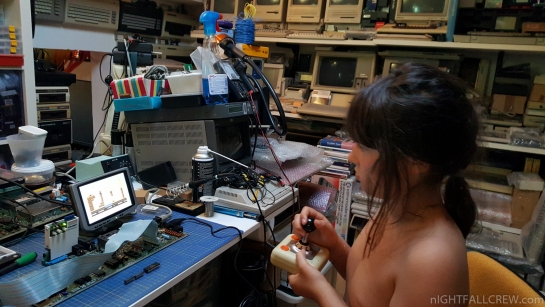
Commodore 64C (ASSY 250469) Repair (1 of 2)
Defect:
- Garbage Screen/Auto Load/Device not Present.
Replaced parts/Fixes:
- 1 x MOS 6526 (U1)
- 2 x Diode 1n4148 (CR9/CR11)
- Rebuilt a pcb track (see photo)
Note:
- As you can see from the photo of the the broken pcb track, evidently someone did a short circuit on the IEC connector on the data lines: SRQin and DATA.
Gallery of the repair:
Commodore 64C (ASSY 250469) Repair (2 of 2)
Defect:
Replaced parts:
- 1 x MOS 8580R5 SID in short circuit (U9)
- 2 x TMS 4464 RAM (U10/U11)
Gallery of the repair:
Commodore 64 (ASSY 250407) Repair (1 of 2)
This Commodore 64 has been already repaired in years past.
Defect:
- Grabage screen/Out of Memory.
Replaced parts:
- 5 x MT 4264-15 RAM (U10/U11/U12/U21/U23)
Gallery of the repair:
Commodore 64 (ASSY 250425) Repair (2 of 2)
Defect:
- Black Screen ..then.. Grabage screen ..then (when hot).. Screen out of Sync
Replaced parts:
- 2 x MT 4264-15 RAM (U11/U23)
- 1 x MOS 901227-03 Kernel ROM (U4)
- 1 x MOS 8701 Clock Generator (U31)
Cleaning Tape and User port connectors.
Gallery of the repair:

This is the official demo party results from Gubbdata 2016 (Top 3 Entries only). See also the CSDB GUBBDATA 2016 section for more informations.
C64 Demo:
- 1 – Nothing but PETSCII by Genesis Project
- 2 – Classics by Booze Design
- 3 – Monochrome by Triad
C64 Music:
- 1 – Nothing Compares 2 EU by Fegolhuzz
- 2 – Ruins by X-jammer
- 3 – 2 Days by Magnar Harestad
C64 Graphics:
- 1 – Cock Picture by ilesj
- 2 – Korvsatan by Razorback
- 3 – Elsewhere by Mermaid
C64 Mixed Graphics:
- 1 – Glad Gubbe by Genesis Project, Vision
- 2 – Duelling Invaders by Genesis Project
- 3 – Green Falcon by PVM
Download: Gubbdata 2016 Party stuff (1071)
source: gubbdata.se
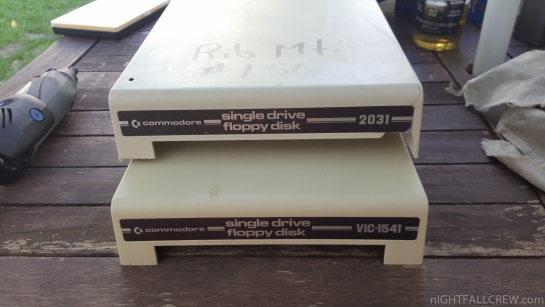
I have sacrificed a Floppy Disk Drive Commodore VIC 1541 to give a new look to a Floppy Disk Drive Commodore 2031 (IEEE-488).
It ‘s not been an easy job, but i’d say the result is very good.
Gallery:
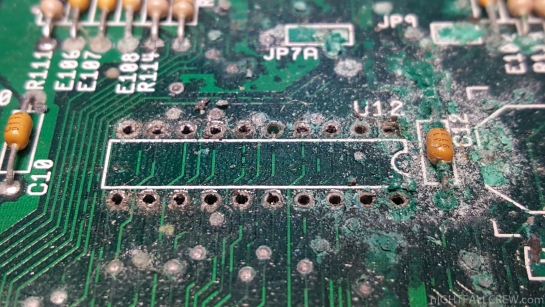
Commodore Amiga 500+ (Battery Acid Leaked) Repair
Defect:
Components replaced and fixes:
- Battery Removed.
- Cleaned the PCB with PCC Kontakt
- Sprayed DUE-CI G-22 on all IC sockets.
- Made ten bridges to restore the traces corroded by the acid of the battery.
- Replaced 1 x 74LS244 (U12)
- Replaced 1 x 74LS373 (U13)
Gallery of the repair:
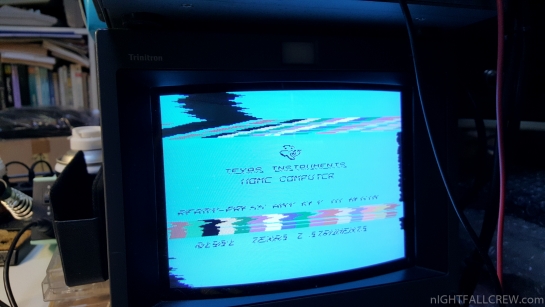
Texas Instruments TI-99/4A Repair (Wave/Raster Lines)
Defect:
- Wave/Raster Lines (see photo).
Replaced parts:
- 1 x Variable Inductor 2 -> 4.5 μH (L100).
Gallery of the repair:
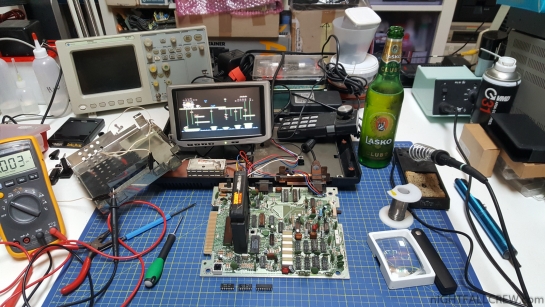
CBS Coleco Vision Repair (Black/Garbage Screen)
Defect:
- Black Screen and then Garbage Screen.
Components replaced:
- 1 x 2114 Static Ram (U4)
- 2 x 4116 Dynamic Ram (U11/U14)
Gallery of the repair:
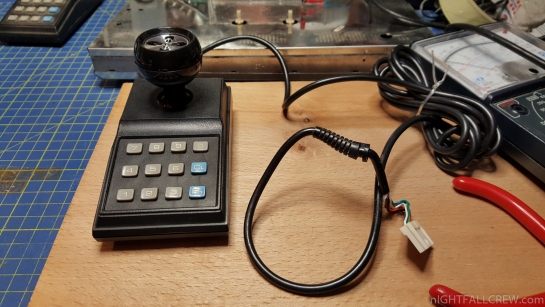
APF Electronics Inc MP-1000 (1978) – Joystick Repair
Defect:
Fix:
- The adhesive tape has dried and the conductive pad move inside the joystick. I have disassembled,cleaned and used a new adhesive tape, now they are like new.
- Replaced the fire button on one of the two joystick completely dead.
Gallery of the repair:
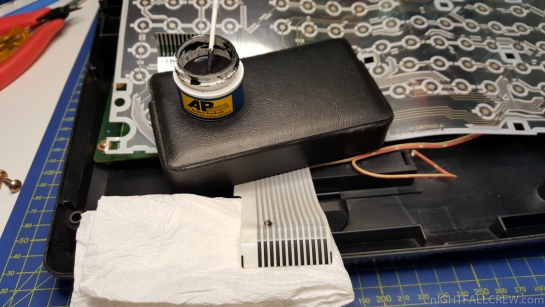
I used a product to regenerate the rubber keypad of remote controls to repair the keyboard flat cable of a Home Computer MSX.
I have used this product many times for my work of Retro Computer restoration but never to regenerate the rubber keypad of remote controls :D
Gallery of the repair:
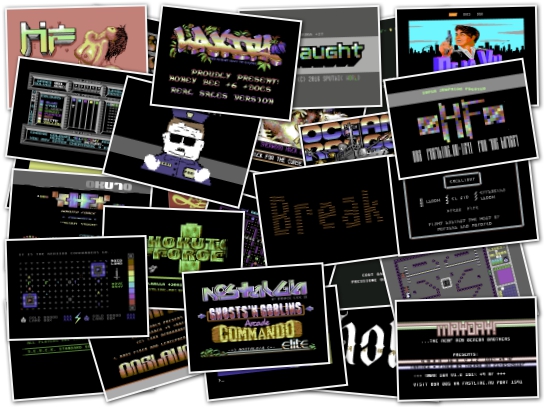
Some new games or tools (Cracked / Trained or Unrealeased) for Commodore 64 have been released from your favorites groups.
Titles:
- QWAK 1.2 +4H
- QWAK 1.2 16K Compo Final
- QWAK 16K V1.2 +4HF
- Evil Garden +4D
- Scout +5DGH
- Ghosts’n Goblins Arcade / Commando Arcade SE / Bruce Lee II [easyflash] [bugfixed]
- Munch Load +M
- Zorro in Wonderland 2 Preview
- Color Code
- Sea Slug +3D
- Honey Bee [real sales version] +6D
- Challenge of the Gobots on the Moebius Strip +5DGH
- Deja Vu & Uninvited +1DW [easyflash]
- Excalibur +
- Ocean Ranger [1581,FD,HD]
- Mission Odessa +2DTS
- Excalibur
- The Curse of Sherwood +26D
- V.I.O.S. (Special Edition 2011) +2 [seuck]
- Estados of Brasil
- States of Brazil
- Kabura
- Gunslinger [1581,FD,HD]
- Valhalla +3DMS
- Tycoon Tex Preview +2
- Dorks Dilemma Preview +2
- Kabura +2T
- The Crown of Ariiance
- Breakaway
- Super Jumpkick Preview
Download: All Games in One Archive (3756)
source: csdb.dk

CBM prg Studio Version 3.5.0 is released. There are a lot of new features in this version. I’d really appreciate it if you report any bugs you find or have any suggestions/comments.
CBM prg Studio allows you to type a BASIC or Machine Code program in using a nice Windows environment and convert it to a ‘.prg’ file which you can run on an emulator, or even a real C64 / VIC20 or PET if you’re feeling brave and have the right kit.
CBM prg Studio is the result of merging C64PrgGen and VIC20PrgGen. Adding new features and fixing bugs in two apps which were 95% similar was a bit of a nightmare so merging them made sense.
It was also a good opportunity for a face lift and to add some new features, such as:
- Programs are project based, meaning all related source files, sprite files etc. are kept in one place and multiple source files can be linked more easily.
- Tabbed MDI.
- Syntax highlighting.
What CBM prg Studio isn’t is a front-end for tok64, cbmcnvrt, bastext or any other tokeniser / detokeniser / assembler. It’s all been written completely from scratch.
New features in v3.8.0:
- Assembler:
- Logical operators.
- Code relocation.
- Watch labels/addresses.
- Local character mapping.
- Screen Editor:
- More export options.
- Change border colour.
- Sprite Editor:
- Multiple layers for preview.
- Invert sprite.
- General:
- Load VICE palettes.
- Open a command line.
Bugs Fixed:
- General:
- Remember ‘close start page’ state.
- Sprite editor:
- Imported sprites had the same data.
- Select mode on scratch pad didn’t work.
- Screen code builder:
- Left arrow generated wrong code.
- Character editor:
- Export characters as hexadecimal.
- Multicolour chars flip left/right not working.
See the help for a complete list of new features and fixed bugs.
Note In this version, each target machine can have its own default project directory. If you are upgrading from a previous version (before version 2.5.1) of CBM prg Studio you may be asked to set up your project directories again. Your current projects will not be affected.
Download: CBM prg Studio v3.8.0 (985)
source: ajordison.co.uk
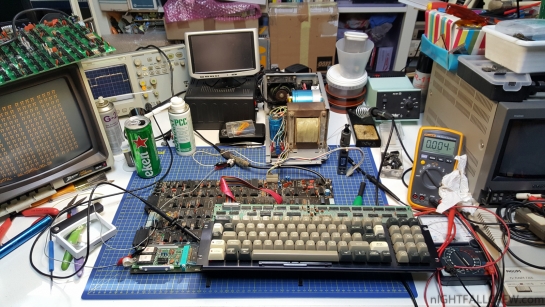
Below the description of the repairing of two Processor Technology SOL-20.
Processor Technology SOL-20 #1 Repair
Defect:
First of ALL!
- You should never replace CD4029 with HCF4029 although apparently could work and maybe it works .. on some motherboard could do bizarre defects or video glitches, like a split screen!
Components replaced and fixes:
- Replaced all IC series HCF 4XXX HCF with the right CD 4XXX series.
- Sprayed DUE-CI G-22 on all Texas Instruments IC sockets.
- Replaced wrong ic 74LS157 in place of a 74LS367 (U29)
- Rebuild broken pcb track near the caps (C15)
- Replaced wrong capacitor of 22uf in place of a 1uf (C67)
- Rebuild bridges under the IC U46 that has seen better days.
- Replaced Capacitor (C31)
- Remake cold welding on the PSU connector and the socket of CPU Intel 8080A.
- Removed a little piece of solder under a socket (see photo)
- Replaced 74LS138 (U34) dead without reason while typing this text on the SOL-20 (FUCKKKK!!!!!!!!!)
… Some Beers… :-D
Gallery of the repair:
Processor Technology SOL-20 #2 Repair
Defect:
First of ALL!
- You should never replace CD4029 with HCF4029 although apparently could work and maybe it works .. on some motherboard could do a bizarre defects or video glitches!
Components replaced and fixes:
- Replaced all IC series HCF 4XXX HCF with the right CD 4XXX series.
- Sprayed DUE-CI G-22 on all Texas Instruments IC sockets.
- Cleaned the motherboard and connectors with Kontakt PCC (Printed Circuits Cleaner)
- Temporarily removed the IC 74LS136 (U22) which put in short-circuit the personality card and burned the 74LS04 (U24). Probably this is a “homebrew” modification for a particular Personality card.
- Replaced wrong ic 74LS04 (U23) in place of a 74LS20 (U23)
- Replaced RAM 2102 (U15)
Note:
- Many sockets not of the Texas Instruments completely rusted are previously been replaced by the owner of this computer (Alessandro Polito).
Gallery of the repair:
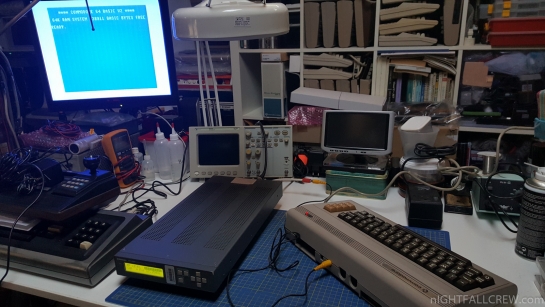
TekTronix DS1000G (NTSC version) Television Demodulator
The television demodulator can demodulate M/N standard television signals to baseband video and audio. In addition, the DS1001G provides the capability of recognizinga GCR signal and applying
correction to the baseband video output.
TheDS1001A/DS1001G covers the tuning range of 55.25 to 801.25MHz. The high performance of the conversion guarantees a measurement-quality signal after demodulation.
Gallery:
Download: TekTronix DS1000G Manual (1138)
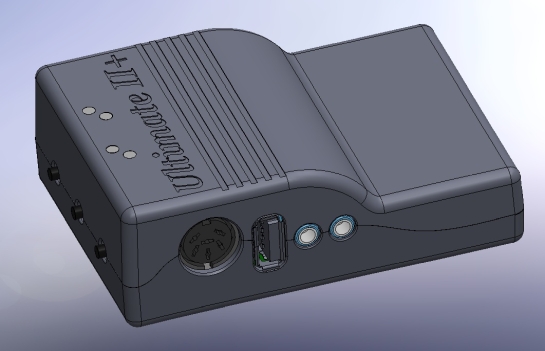
…from the author website:
Since the end of 2015, it became clear that the “good old” 1541 Ultimate-II was at the end of its life cycle. Xilinx, the manufacturer of the most important chip of the cartridge, had started to increase the prices of the chip. Also the memory chip started to be harder to get and at higher cost. When the news came that the company that made the black plastic cases for the 1541 Ultimate-II had lost the injection mold tool, it became evident that the 1541 Ultimate-II would be no more.
I have given it some thought. What would be the best way to continue with this project? When the feelings of being upset about the lost injection tool had subsided, I realized that this may be the perfect moment for an upgrade. This is when set backs change into opportunity.
Since then, a lot of work, and I really mean A LOT OF WORK has been done to create a successor: the “Ultimate-II+”. Why not “III”, you may ask or think. Well, the foremost reason is the software. The install base of the “1541 Ultimate-II” is rather large (>3000 units), and I do not want to let my customers down that have just purchased a unit. This means that in case of new hardware, the same software should run on both the new board, as well as on the older board. So, the new board will offer similar functionality. You could see it just as an upgrade, not an entirely new product.
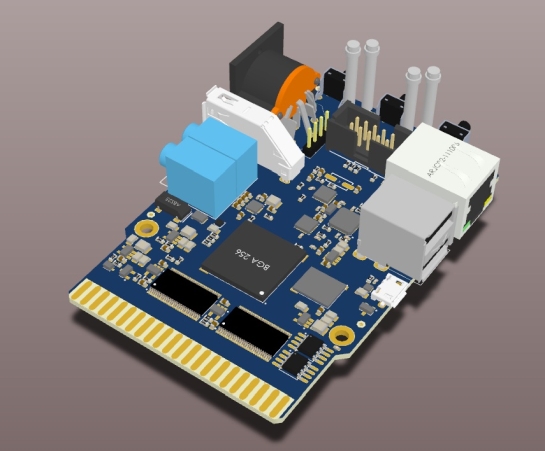
Although the “Ultimate-II+” is similar, there are also differences:
- No more MicroSD! (… that needs to be pushed in with something sharp, could fall into the case, … etc)
- More USB ports (… one to compensate for the lost SD, and just one bonus: 3 in total)
- IEC connector moved (… further back to facilitate use on some C128 models)
- Integrated Ethernet (… no more need for an external USB2LAN adapter, and a smaller step to CS8900A compatibility)
- Dual Flash (… no more worry that a software bug or upgrade failure leads to a bricked device)
- Integrated Speaker (… who connects a speaker set to the audio jack for hearing drive sounds??)
- External power supply connector with auto-switch over circuit (… for stand alone mode, and to lower the demand on the power supply of the C64)
- Improved Audio (… audio codec, 24 bit/96 kHz*, for sampled sounds and SID emulation)
- Improved Tape connector (… no more custom board and able that snaps in on the bottom, but standard USB 3.0 cable)
- Improved power supply circuits (… for some reason they seemed to break down relatively often)
- Slightly bigger and faster FPGA, as to control the new features
source: 1541ultimate.net

A new version of the firmware for the interface 1541 Ultimate II is released. This version runs only on the 1541 Ultimate II cartridge (new fpga).
Release notes 3.0 beta 7:
r297 | gideonz | 2016-04-15 21:27:25 +0200 (Fri, 15 Apr 2016)
- Prepared for release 3.0b7
- Processor flag error fixed.
- Some 6502 opcode testing done. Fixed ADC in decimal mode.
Some fixes:
- ISSUE 189: Mount disk is now performed when C64/drive is not frozen
- ISSUE 191: Loading a file from within T64 (and D64) could fail at times due to special chars. Fixed
- ISSUE 193: Tape grab to TAP file fixed (at least that the option to run it will work)
- ISSUE 204: TCP slowdown fixed; bug in USB driver
- ISSUE 207: Typo fixed that caused “Save to disk” to fail with a 0 byte file
- OTHER: SID file with faulty header now no longer causes Flash corruption
- OTHER: Tape play / record functions updated
r276 | soci | 2016-01-17 07:35:38 +0100 (Sun, 17 Jan 2016)
- Fix wrong DDRA readback (typo)
- The TASM-RR cartridge is not REU compatible
- Fix for PB6/7 keyboard freeze bug
Download: 1541 Ultimate II Firmware v3.0 Beta 7 (1342)
source: 1541ultimate.net









Recent Comments